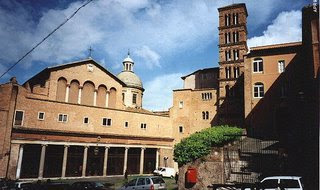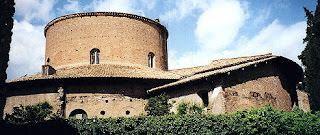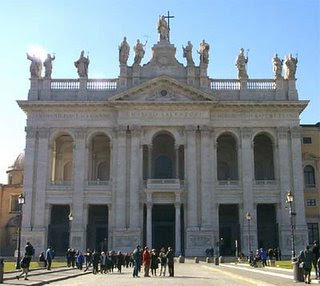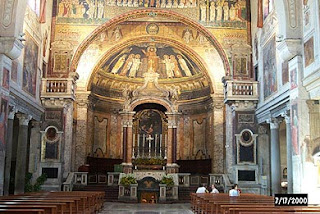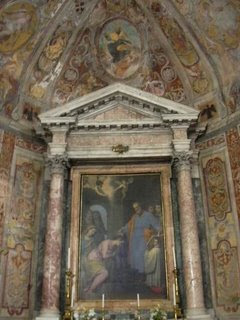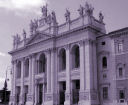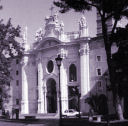
Wednesday of Holy Week
Isaiah 50:4-9
Psalm 68: 8-10, 21bcd-22, 31 & 33-34 (R. 14C & b)
Matthew 26:14-25
At Saint Mary Major
Today’s Roman Stational Church is the Basilica of Saint Mary Major. We go, in spirit, to this ancient church of the Mother of God, asking her to be present to us as we prepare to cross the threshold into the Paschal Triduum. We go to the suffering Christ, to the Crucified, to the Risen One with and through his most holy Mother. The Virgin of Sorrows is the Portress of the Holy Mysteries, the Keeper of the Door of Christ’s Pierced Heart, the Mother of our Joy. We will return again to Saint Mary Major for the Mass of Easter Day to sing our joy to the Mother of God -- Regina caeli, laetare! -- and to share in the joy that was hers at the resurrection of Christ. By framing the Paschal Triduum between two stations at the church of Saint Mary Major, the Roman liturgy suggests that the mystery of Christ is given us enveloped in Mary. Mary, like the Church, embodies and contains the mystery of Christ.
Christ in the Glory of God the Father
We sing today’s Introit in the presence of the Mother of Jesus. “In the name of Jesus let every knee bow, of those that are in heaven, on earth, and under the earth; for the Lord became obedient unto death, even to the death of the cross. Therefore our Lord Jesus Christ is in the glory of God the Father (Phil 2:10, 8, 11). She who was the witness of his sufferings on Calvary is the witness of his glory in heaven, for she “has chosen the better part which shall not be taken away from her” (Lk 10:42).
We confess the self-emptying obedience of Christ, obedience even to the death of the cross, calling him LORD. We summon the entire cosmos -- things in heaven, on earth, and under the earth -- to adoration of his Name! Already, we lift our eyes to the see the glory of the risen and ascended Christ. The very melody of the introit scales an entire octave to soar into the heights, obliging us to “seek the things that are above” (Col 3:1). Dame Aemiliana speaks of “the irresistible, shining tone of triumph with which today’s Mass straightaway puts the approaching shadows of evening to flight.” Like Saint Stephen at the hour of his death, we see Christ in the glory of God the Father. “Behold, I see the heavens opened, and the Son of Man standing on the right hand of God” (Ac 7:56). The Crucified is our Kyrios, the triumphant king, raised up into the glory of the Father.
Gibbeted on the Cross
The Collect echoes the Introit with its motif of cross and resurrection. Monsignor Knox translates it this way: “For our sakes, O God, and of the fiend’s power to rid us, thou wouldst have thy Son gibbeted on the Cross; O that we thy servants, may find grace to rise again with him.” The Latin text refers to the patibulum of the cross, the gibbet, an instrument of torture and execution. Christ, though innocent, goes to a criminal’s death. The cross is attached to the body of Christ to become the instrument by which he routs the power of the enemy.
The Tree and the Garden
The wood by which Satan sought to uproot the kingdom of God from creation becomes the wood by which Satan is catapulted out of it. The tree by which Satan sought to poison the good and beautiful work of God in the beginning -- “And God saw everything that he had made, and behold it was very good” (Gen 1:31) -- becomes the new shoot by which God’s lovely garden is replanted to flourish, irrigated by the water and the blood flowing from the side of Christ. Here too is an echo of the cosmic imagery of the Introit: “. . . . in heaven, on earth, and under the earth.” “Behold,” he says, “I make all things new” (Rev 21:5).
Newness of Life
We ask in the Collect that we may come to the grace of the resurrection. The Prayer Over the People will spell out for us exactly what this means: newness of life. The grace of the resurrection means forsaking all the old and ugly things by which we open the garden of Christ’s new creation to the hateful hissing of the Evil One. For Saint Bernard and his disciples the monastery is to be nothing less than a paradisus claustralis, a cloistered paradise, a garden enclosed in which one lives a new life, a life made beautiful by grace. “A garden enclosed is my sister, my bride, a garden enclosed, a fountain sealed” (Ct 4:12).
We are to let go of what is old. The hope-chest of the bride of Christ is empty; it is the treasure of her poverty. We are to hold nothing of the sinful past in reserve. Only then will we be able to inhale the sweet fragrance of the risen Christ. Only then will Christ say to each of us, “Your lips distill nectar, my bride; honey and milk are under your tongue; the scent of your garments is like the scent of Lebanon” (Ct 4:11).
Christ Sustains the Weary
All of this would be daunting were we not sustained by the word of the suffering Christ. “The Lord God,” he says “has given me the tongue of those who are taught, that I may know how to sustain with a word him that is weary” (Is 50:4). Christ sustains us in our weariness with every word of his uttered from the cross. He sustains us with every word of his repeated by the Church, over and over again, in the Psalter. He sustains us with every word of his heard, repeated, prayed, and held in the heart by means of lectio divina. Every word of his is, in some way, the application of the virtus crucis, the power of the cross, to our infirmity, to our weakness, to our misshapen, fragmented, selves. It is by the word of the suffering Christ, a communication of the power of the cross, that we are changed, that the garden of his delights is planted in the midst of us, that things broken are made whole again. The cross of Christ is both ambo and altar. From the ambo of the cross our Lord utters the word that sustains; from the altar of the cross he gives the sacrificial food of his Body and Blood.
Tears in His Chalice
The Communion Antiphon begins today with a mysterious word, a word of the suffering Christ, given to sustain us. Potum meum cum fletu temperebam. “I mingled my drink with weeping” (Ps 101:10). The chalice is given Christ by the Father. “Father, if thou art willing, remove this cup from me; nevertheless not my will, but thine, be done” (Lk 22:42). The chalice of Christ’s sufferings is made full when he adds to it his own tears, the tears of a Man, the tears of God. This is the chalice offered us in the Eucharist: a communion with the suffering Christ, a communion in his blood and in his tears. He mingled his drink with weeping to make our drink sweet. He was lifted up and thrown down (cf. Ps 101:10) that we who are thrown down might, by grace, be lifted up. He became withered like the grass (cf. Ps 101:11) that the garden of the kingdom might be planted and flourish and grow beautiful among us.
The Time to Have Mercy
See, already he arises to have mercy on Sion (cf. Ps 101:13), for the time to have mercy is come! At Cana he said to his mother Mary, “My hour has not yet come” (Jn 2:4). Today, Mother Church sings, “The time to have mercy is come” (Ps 101:13). With these words she ushers in these final hours before the Paschal Triduum. It is the time to have mercy.
